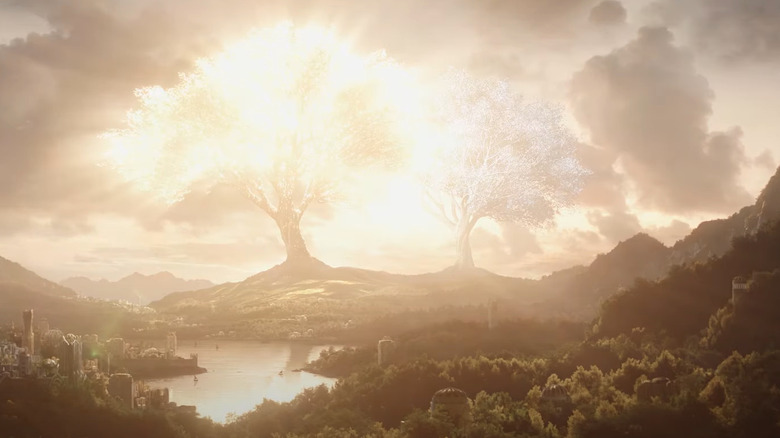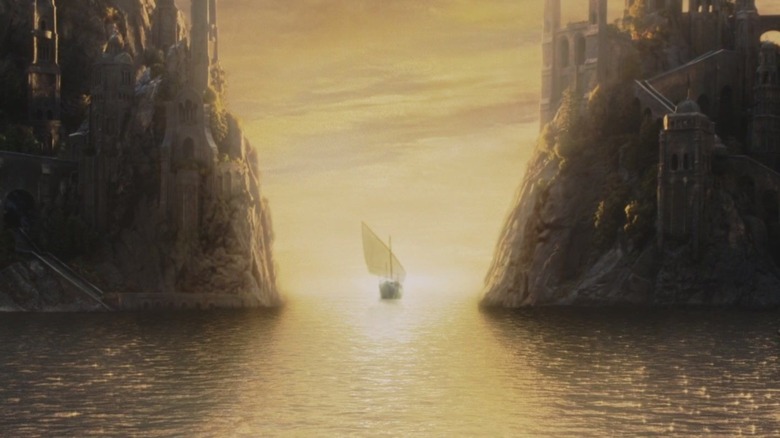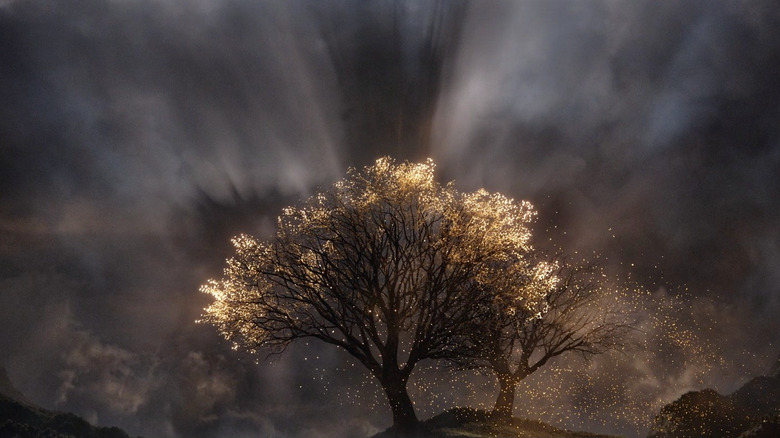The Lord Of The Rings: What Are The Undying Lands & How Did They Get To Mars?
J. R. R. Tolkien's legendarium is vast and intricate. The plethora of books that the Oxford professor wrote detail tens of thousands of years of history, stretching back to the beginning of time and even before it. One area that gets a lot of attention in these earlier annals is called the Undying Lands.
This refers to a massive continent across from the western coastlands of Middle-earth (off to the left side of the map). This is the area that Frodo (Elijah Wood) and Bilbo (Ian Holm) sail off to at the end of "The Return of the King." It's also the area that Galadriel (Morfydd Clark) and her fellow Elvish warriors reach by boat at the beginning of Season 1 of "The Rings of Power" before the she-elf jumps ship and starts her gargantuan swimming marathon back to Middle-earth.
Technically speaking, the land mass we're talking about is the continent of Aman. The massive area runs far to the north and south of Tolkien's world (collectively called Eä). Aman contains a gigantic vertical spine of towering mountains called the Pelóri. These run down the eastern edge of the landmass and were originally created as a barrier of protection against the Dark Lord Morgoth early in the history of Middle-earth. It's worth noting that there is a very important island off of the continent's eastern coast called Tol Eressëa that is also considered part of this holy landmass.
Along with the collective term Undying Lands, both parts of Aman and the continent as a whole are given many different names, including Valinor, the Blessed Realm, Eldamar, and the Uttermost West. It's even mentioned in "The Hobbit," where the Wood Elves are described as distinctly different from the High Elves who went to "Faerie in the West."
Are the Undying Lands immortal?
Based on the name, it's tempting to think of the Undying Lands as an immortal area of the world, almost like an unfallen Middle-earth Garden of Eden. But J. R. R. Tolkien indicated that the beings living in Aman gave the area the name the Undying Lands, not because the land made them immortal but because they were already immortal when they arrived. This is reinforced by the fact that mortal guests, like Frodo, don't become immortal. In a letter to a reader in 1963, the author explained, "Frodo was sent or allowed to pass over Sea to heal him – if that could be done, before he died. He would have eventually to 'pass away': no mortal could, or can, abide for ever on earth, or within Time."
The natural follow-up question there is: Who are these immortals who live in the Undying Lands? Unsurprisingly, there are Elves there. But they didn't originate in Aman. They were brought there by the angelic race called the Ainur, spiritual beings who help order the events of the world, and are led by fourteen beings called the Valar.
The term Undying Lands doesn't appear to come from its immortal inhabitants either, but rather the mortal Men who are not allowed on its hallowed shores. The appendices of "The Return of the King" states that when the island of Númenor is created in sight of Aman, the race of Men that lives there are strictly banned from visiting Aman. The text reads, "They were forbidden to sail west out of sight of their own shores or to attempt to set foot on the Undying Lands." This concept of "mere mortals" being kept from immortality is what ultimately corrupts the Númenóreans' top brass and leads to the Atlantis-like destruction of their island kingdom.
A brief history of the Undying Lands
So, how do the Undying Lands factor into Middle-earth history? While they're only occasionally mentioned in "The Hobbit" and "The Lord of the Rings" stories, books like "The Silmarillion" and "Unfinished Tales" shed a lot more light on the backstory of this mysterious eastern continent. Very early on, before the Elves or Men are even on the scene, the original Dark Lord Morgoth attacks the Valar. The cataclysmic super-powered fight causes catastrophic destruction, and the Valar end up relocating west, where they set up shop in Aman — specifically, an area called Valinor.
Eventually, the Elves arrive on the scene. Rather than help them build a life in Middle-earth, the Valar bring as many of them as they can overseas to the Undying Lands. There, they live for a long time before Morgoth mars their happiness yet again, causing many of the Elves to leave the Blessed Realm to confront the Dark Lord back in Middle-earth.
At this point, we're in the First Age of Middle-earth, when J. R. R. Tolkien's narrative becomes more detailed and focused on groups like the Elves, Men, and Dwarves. As history unfolds and the ages go by, the Valar, Ainur, and remaining Elves continue to dwell away in the blessed West. Initially, they give Númenor to its Mannish inhabitants, but when the ungrateful mortals attack the Undying Lands, Ilúvatar (Tolkien's God equivalent) intervenes, sinking the human island and physically hiding the Undying Lands from the world.
At this point, the only way to get to the Undying Lands becomes a secret path that only certain Elvish mariners are aware of. This is how the Elves continue to slowly evacuate Middle-earth, and eventually, how Frodo and Bilbo are also able to hitch a ride to the immortal country.
The Undying Lands are ... on Mars?
Now comes the weirdest connection of all. While the Undying Lands may be hidden in J. R. R. Tolkien's texts, they're a very real place in reality — at least, they are ever since January 18, 2024. On that day, NASA's Ingenuity Mars Helicopter, part of its Perseverance Mars rover, crash-landed and came to its final resting place on its 72nd flight on the Red Planet. It turns out that at least some members of the space chopper's remote flight team are Tolkien fans, as the agency announced on February 6, 2024 that the group nicknamed its final location Valinor Hills.
It's not a coincidence. The report specifically reads, "The Ingenuity team has nicknamed the spot where the helicopter completed its final flight 'Valinor Hills' after the fictional location in J.R.R. Tolkien's fantasy novels, which include 'The Lord of the Rings' trilogy."
If we're being nitpicky, Valinor is an entire region of Aman, not just hills. The continent's massive Pelóri mountain range might have been a better title fit. Still, just knowing that the NASA team is up to date on their Tolkien lore enough to name the area after such an obscure corner of Middle-earth is enough to make any Tolkienite proud.
Besides, it's fun to know that now, a very real part of our universe is named after the Blessed Realm. There may not be immortal beings around to populate it, but there is a very real version of the Undying Lands in our plane of existence now, and the fact that it's on Mars gives it a mythic — dare we say immortal — quality all its own.



